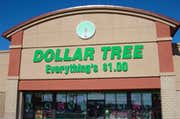All businesses that sell goods and services to consumers fall under the umbrella of retailing, but there are several directions we can take from here. For starters, there are department stores, discount stores, specialty stores and even seasonal retailers. Each of these might have their own little quirks; however, for the most part the analysis overlaps to all areas of retailing. This section of the industry handbook will try to focus more on general retailers and department stores. (For background reading, see Analyzing Retail Stocks.)
Over the past couple decades, there have been sweeping changes in the general retailing business. What was once strictly a made-to-order market for clothing has changed to a ready-to-wear market. Flipping through a catalog, picking the color, size and type of clothing a person wanted to purchase and then waiting to have it sewn and shipped was standard practice. At the turn of the century some retailers would have a storefront where people could browse. Meanwhile, new pieces were being sewn or customized in the back rooms.
In some parts of the world, the retail business is dominated by smaller family-run or regionally-targeted stores, but this market is increasingly being taken over by billion-dollar multinational conglomerates like Wal-Mart and Sears. The larger retailers have managed to set up huge supply/distribution chains, inventory management systems, financing pacts and wide scale marketing plans.
Without getting into specific product categories within the retailing industry, the overall segments can be divided into two categories:
Each retailer tries to differentiate itself from the competition, but the strategy that the company uses to sell its products is the most important factor. Here are some different types of retailers:
Each of these has its own distinct advantages, but it's important to know how these advantages play out. For example, during tough economic times, the discount retailers tend to outperform the others. The opposite is true when the economy is thriving. The more successful retailers attempt to combine the characteristics of more than one type of retailer to differentiate themselves from the competition.
Key Ratios/Terms
Same Store Sales: Used when analyzing individual retailers. It compares sales in stores that have been open for a year or more. This allows investors to compare what proportion of new sales have come from sales growth compared to the opening of new stores. This is important because although new stores are good, there eventually comes a saturation point at which future sales growth comes at the expense of losses at other locations. Same store sales are also commonly referred to as "comps."
Sales per Square Foot: Sales
Square Footage
Store space is considered to be a productive asset and the key to profitability. Successful companies generate as much sales volume as possible out of each square foot of store space. More recently, analysts have created modifications of this concept by looking at a retailers' gross margin per square foot.
Inventory Turnover: This ratio shows how many times the inventory of a firm is sold and replaced over a specific period.
Generally calculated as: Sales
Inventory
But, may also be calculated as: Cost of Goods Sold
Average Inventory
Although the first calculation is more frequently used, COGS may be substituted because sales are recorded at market value while inventories are usually recorded at cost. Also, average inventory may be used instead of the ending inventory to help minimize seasonal factors. This ratio should be compared against similar retail companies or the industry average. A low turnover might imply poor sales and, therefore, excess inventory. A high ratio implies either strong sales or ineffective buying from suppliers. (For related reading, see
Consumer Confidence: The Consumer Confidence Index (CCI) is put out by the Consumer Confidence Board around the middle of each month. The Consumer Confidence Survey is based on a sample of 5,000 U.S. households and is considered to be one of the most accurate indicators of confidence. Increasing confidence means more spending and borrowing for consumers - a positive for retailers. (To learn more about this measure, see Economic Indicators To Know: Consumer Confidence Index.)
Personal Income & Disposable Income: Every quarter, the Bureau of Economic Analysis releases the latest income data for U.S. citizens. There is a high correlation between retail sales data and the changes in personal income. (For more insight, see Economic Indicators: Personal Income and Outlays.)
Analyst Insight
As we mentioned earlier, the store type and the strategy that retailers use plays a big role in how well the company performs. The first thing to take a look at is what segment of the retail industry the company is situated in. Is the company a discounter? Department store? Specialty retailer? The retail category to which the company belongs also helps determine the following details about the company:
The performance of the economy as a whole obviously has a great impact on the retailing industry. Retailer profits have a close correlation with the overall performance of the economy. Looking at the trends for growth in gross domestic product (GDP), inflation, consumer confidence, personal income and interest rates are extremely important when thinking about investing in the retail industry. You might not think that your shopping habits are sensitive to interest rate fluctuations, but they are. While a 50-basis-point drop in interest rates might not give you the sudden inkling to go drop $1,000 at Macy's, for the economy as a whole, it has a big effect on spending patterns. (For more insight on this effect, see How Interest Rates Affect The Stock Market.)
After looking at the macroeconomic factors and the industry as a whole, it is time to delve into the financial statements. The biggest problem for analyzing these companies is the lack of consistency between accounting procedures. It takes a careful eye when comparing performance ratios and figures from one company to the next. For example, some companies tend to include shipping and storage in their cost of goods sold, while others list it as a separate expense. This is why you must read all the notes to the financial statements and gain a better understanding of what is and isn't included in the various figures. (To learn more, read Footnotes: Start Reading The Fine Print.)
Aside from earnings and revenue growth, one important thing to look at is the markup percentage for the retailer. This is also known as the gross profit margin (sales minus cost of goods sold). Unfortunately, there is not one margin that every retailer should use: discount stores generally have lower margins compared to other general merchandisers. When comparing these numbers, higher margins are usually better because it means the company has more room to work with during price wars, intensified competition or when demand slows.
Inventory is also a key figure to pay close attention to as without it, retailers don't have anything to sell. A company's inventory situation depends on what type of products it offers. For example, the inventory turnover for a grocery store (with perishable goods) will be higher than that of a department store. Compare the turnover rates of direct competitors: those with higher rates tend to have fresh new products that sell more frequently. Keep in mind that an increase in inventory is not always a cause for alarm. Sometimes inventory will increase as a result of new stores opening or the expansion of existing stores. Therefore, compare the increase in inventory to the growth of new stores to see if there is more to the story. (For more on inventory evaluation, read Measuring Company Efficiency.)
As one final caveat (beware) when looking at performance data and financial statements for retailers is to compare them against the same period for the previous year. Holiday spending and other seasonal factors can mean wild swings in financial results from one quarter to the next. Compare the Christmas season results for the company over the same season from previous years. There isn't one store out there that doesn't see an increase in sales during the month of December, so don't be fooled by comparisons to preceding months. This is why year-over-year same store sales figures are so widely followed by investors and analysts. When retailers release their same store sales figures on the first or second Thursday of every month, they are usually compared to the same time period from previous years. To take this one step further, compare sales data for more than just one month. Aggressive marketing or discounts can skew data for one particular month; therefore, you need to look at the overall trend in same store sales over several months.
Porter's 5 Forces Analysis
The Industry Handbook: The Banking Industry
Over the past couple decades, there have been sweeping changes in the general retailing business. What was once strictly a made-to-order market for clothing has changed to a ready-to-wear market. Flipping through a catalog, picking the color, size and type of clothing a person wanted to purchase and then waiting to have it sewn and shipped was standard practice. At the turn of the century some retailers would have a storefront where people could browse. Meanwhile, new pieces were being sewn or customized in the back rooms.
In some parts of the world, the retail business is dominated by smaller family-run or regionally-targeted stores, but this market is increasingly being taken over by billion-dollar multinational conglomerates like Wal-Mart and Sears. The larger retailers have managed to set up huge supply/distribution chains, inventory management systems, financing pacts and wide scale marketing plans.
Without getting into specific product categories within the retailing industry, the overall segments can be divided into two categories:
- Hard - These types of goods include appliances, electronics, furniture, sporting goods, etc. Sometimes referred to as "hardline retailers."
- Soft - This category includes clothing, apparel, and other fabrics.
Each retailer tries to differentiate itself from the competition, but the strategy that the company uses to sell its products is the most important factor. Here are some different types of retailers:
- Department Stores - Very large stores offering a huge assortment of goods and services.
- Discounters - These also tend to offer a wide array of products and services, but they compete mainly on price.
- Demographic - These are retailers that aim at one particular segment. High-end retailers focusing on wealthy individuals would be a good example.
Each of these has its own distinct advantages, but it's important to know how these advantages play out. For example, during tough economic times, the discount retailers tend to outperform the others. The opposite is true when the economy is thriving. The more successful retailers attempt to combine the characteristics of more than one type of retailer to differentiate themselves from the competition.
Key Ratios/Terms
Same Store Sales: Used when analyzing individual retailers. It compares sales in stores that have been open for a year or more. This allows investors to compare what proportion of new sales have come from sales growth compared to the opening of new stores. This is important because although new stores are good, there eventually comes a saturation point at which future sales growth comes at the expense of losses at other locations. Same store sales are also commonly referred to as "comps."
Sales per Square Foot: Sales
Square Footage
Store space is considered to be a productive asset and the key to profitability. Successful companies generate as much sales volume as possible out of each square foot of store space. More recently, analysts have created modifications of this concept by looking at a retailers' gross margin per square foot.
Inventory Turnover: This ratio shows how many times the inventory of a firm is sold and replaced over a specific period.
Generally calculated as: Sales
Inventory
But, may also be calculated as: Cost of Goods Sold
Average Inventory
Although the first calculation is more frequently used, COGS may be substituted because sales are recorded at market value while inventories are usually recorded at cost. Also, average inventory may be used instead of the ending inventory to help minimize seasonal factors. This ratio should be compared against similar retail companies or the industry average. A low turnover might imply poor sales and, therefore, excess inventory. A high ratio implies either strong sales or ineffective buying from suppliers. (For related reading, see
Consumer Confidence: The Consumer Confidence Index (CCI) is put out by the Consumer Confidence Board around the middle of each month. The Consumer Confidence Survey is based on a sample of 5,000 U.S. households and is considered to be one of the most accurate indicators of confidence. Increasing confidence means more spending and borrowing for consumers - a positive for retailers. (To learn more about this measure, see Economic Indicators To Know: Consumer Confidence Index.)
Personal Income & Disposable Income: Every quarter, the Bureau of Economic Analysis releases the latest income data for U.S. citizens. There is a high correlation between retail sales data and the changes in personal income. (For more insight, see Economic Indicators: Personal Income and Outlays.)
Analyst Insight
As we mentioned earlier, the store type and the strategy that retailers use plays a big role in how well the company performs. The first thing to take a look at is what segment of the retail industry the company is situated in. Is the company a discounter? Department store? Specialty retailer? The retail category to which the company belongs also helps determine the following details about the company:
- Competitors - The number and size of direct competitors is important. Ideally, you want the company to have as little competition as possible, but this rarely happens. Determine who the direct competitors are and how they are all positioned in the market. A smaller regional discount store might find it tough to compete with new Wal-mart stores opening up every month. Take a look at the big picture, find out what differentiates the company from its competitors. Do they have better prices, service, or offer higher quality goods than their competition? Grocery stores might find it hard to differentiate themselves from competitors: after all, an apple is an apple. Higher-end retailers, however, may have an easier time as they try to compete on service or quality.
- Size of the Market - Determining the overall size of the market gives us an indication of the potential for the market. If you had the choice between a company with a 25% share of a $10 million market or a 25% share of a $1 billion market, which one would you chose?
- Other Factors - Some analysts even go as far as evaluating the retail strategy that the companies use. For example, does the company have a fresh look? Are their stores clean, bright and fun to shop in? Swedish retailer Ikea has done an excellent job of designing their stores for visual appeal, and quite possibly it has equated to very strong sales.
The performance of the economy as a whole obviously has a great impact on the retailing industry. Retailer profits have a close correlation with the overall performance of the economy. Looking at the trends for growth in gross domestic product (GDP), inflation, consumer confidence, personal income and interest rates are extremely important when thinking about investing in the retail industry. You might not think that your shopping habits are sensitive to interest rate fluctuations, but they are. While a 50-basis-point drop in interest rates might not give you the sudden inkling to go drop $1,000 at Macy's, for the economy as a whole, it has a big effect on spending patterns. (For more insight on this effect, see How Interest Rates Affect The Stock Market.)
After looking at the macroeconomic factors and the industry as a whole, it is time to delve into the financial statements. The biggest problem for analyzing these companies is the lack of consistency between accounting procedures. It takes a careful eye when comparing performance ratios and figures from one company to the next. For example, some companies tend to include shipping and storage in their cost of goods sold, while others list it as a separate expense. This is why you must read all the notes to the financial statements and gain a better understanding of what is and isn't included in the various figures. (To learn more, read Footnotes: Start Reading The Fine Print.)
Aside from earnings and revenue growth, one important thing to look at is the markup percentage for the retailer. This is also known as the gross profit margin (sales minus cost of goods sold). Unfortunately, there is not one margin that every retailer should use: discount stores generally have lower margins compared to other general merchandisers. When comparing these numbers, higher margins are usually better because it means the company has more room to work with during price wars, intensified competition or when demand slows.
Inventory is also a key figure to pay close attention to as without it, retailers don't have anything to sell. A company's inventory situation depends on what type of products it offers. For example, the inventory turnover for a grocery store (with perishable goods) will be higher than that of a department store. Compare the turnover rates of direct competitors: those with higher rates tend to have fresh new products that sell more frequently. Keep in mind that an increase in inventory is not always a cause for alarm. Sometimes inventory will increase as a result of new stores opening or the expansion of existing stores. Therefore, compare the increase in inventory to the growth of new stores to see if there is more to the story. (For more on inventory evaluation, read Measuring Company Efficiency.)
As one final caveat (beware) when looking at performance data and financial statements for retailers is to compare them against the same period for the previous year. Holiday spending and other seasonal factors can mean wild swings in financial results from one quarter to the next. Compare the Christmas season results for the company over the same season from previous years. There isn't one store out there that doesn't see an increase in sales during the month of December, so don't be fooled by comparisons to preceding months. This is why year-over-year same store sales figures are so widely followed by investors and analysts. When retailers release their same store sales figures on the first or second Thursday of every month, they are usually compared to the same time period from previous years. To take this one step further, compare sales data for more than just one month. Aggressive marketing or discounts can skew data for one particular month; therefore, you need to look at the overall trend in same store sales over several months.
Porter's 5 Forces Analysis
- Threat of New Entrants. One trend that started over a decade ago has been a decreasing number of independent retailers. Walk through any mall and you'll notice that a majority of them are chain stores. While the barriers to start up a store are not impossible to overcome, the ability to establish favorable supply contracts, leases and be competitive is becoming virtually impossible. Their vertical structure and centralized buying gives chain stores a competitive advantage over independent retailers.
- Power of Suppliers. Historically, retailers have tried to exploit relationships with suppliers. A great example was in the 1970s, when Sears sought to dominate the household appliance market. Sears set very high standards for quality; suppliers that didn't meet these standards were dropped from the Sears line. You could also liken this to the strict control that Wal-Mart places on its suppliers. A contract with a large retailer such as Wal-Mart can make or break a small supplier. In the retail industry, suppliers tend to have very little power.
- Power of Buyers. Individually, customers have very little bargaining power with retail stores. It is very difficult to bargain with the clerk at Safeway for a better price on grapes. But as a whole, if customers demand high-quality products at bargain prices, it helps keep retailers honest.
- Availability of Substitutes. The tendency in retail is not to specialize in one good or service, but to deal in a wide range of products and services. This means that what one store offers you will likely find at another store. Retailers offering products that are unique have a distinct or absolute advantage over their competitors.
- Competitive Rivalry. Retailers always face stiff competition. The slow market growth for the retail market means that firms must fight each other for market share. More recently, they have tried to reduce the cutthroat pricing competition by offering frequent flier points, memberships and other special services to try and gain the customer's loyalty.
- Department of Commerce - Get the latest news and statistics for the U.S. economy.
- ChainStoreAge.com - News, polls and opinion articles for the retail industry
- Supermarket News - News and statistics on the food retailing industry
The Industry Handbook: The Banking Industry
Related Articles
-
 Investing
InvestingThe Four Rs of Investing in Retail
Learn about the key success factors to consider for retail companies. -
 Insights
Insights19 Retailers Are Shedding Stores So Far in 2017
As consumers increasingly spend money on restaurants and travel, mall-based retailers feel the pinch. -
 Investing
Investing99 Cents Only Stores Profits Edge Up
Dollar retailer 99 Cents Only increased revenue and profits despite product-cost increases. -
 Investing
Investing5 Retailers Set to Close More Stores in 2016 (FINL, GPS)
Discover retail stores that have already announced plans to close stores in 2016. Some expect a new economic downturn, which may lead more stores to close. -
 Investing
InvestingKey Financial Ratios For The Retail Industry
The retail industry is measured on sales growth in existing store, forecasted based on foot traffic and ticket data, and the impact on profitability ratios. -
 Trading
TradingAre Dollar Stores Really A Bargain?
It's hard to resist an item that's $1. We tell you when you should fight the urge. -
 Investing
InvestingThe World's Top 10 Retailers (WMT, COST)
Read about some of the top retail companies in the world, and learn a little about the products they sell and the markets and customers they serve. -
 Investing
InvestingMacy's Is Closing 68 Stores (M)
The retail behemoth is closing "unproductive" locations and streamlining its operations by laying off workers. -
 Investing
InvestingThe Top 5 Large-Cap Retail Stocks for 2016
Discover the top five large-cap retail companies that will grow in 2016, with detailed explanations of the companies and their growth outlook. -
 Insights
InsightsZara Combats Retail Slump with Mega-Stores
Zara's is shuttering smaller stores and replacing them with massive ones to encourage browsing.



